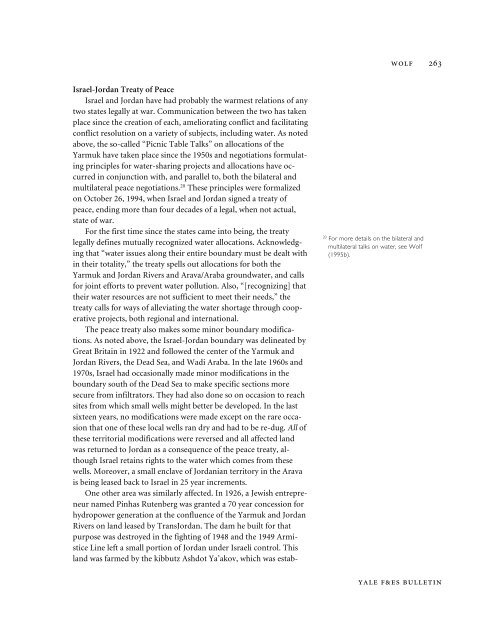Hydrostrategic Decisionmaking and the Arab ... - Yale University
Hydrostrategic Decisionmaking and the Arab ... - Yale University
Hydrostrategic Decisionmaking and the Arab ... - Yale University
You also want an ePaper? Increase the reach of your titles
YUMPU automatically turns print PDFs into web optimized ePapers that Google loves.
WOLF 263Israel-Jordan Treaty of PeaceIsrael <strong>and</strong> Jordan have had probably <strong>the</strong> warmest relations of anytwo states legally at war. Communication between <strong>the</strong> two has takenplace since <strong>the</strong> creation of each, ameliorating conflict <strong>and</strong> facilitatingconflict resolution on a variety of subjects, including water. As notedabove, <strong>the</strong> so-called “Picnic Table Talks” on allocations of <strong>the</strong>Yarmuk have taken place since <strong>the</strong> 1950s <strong>and</strong> negotiations formulatingprinciples for water-sharing projects <strong>and</strong> allocations have occurredin conjunction with, <strong>and</strong> parallel to, both <strong>the</strong> bilateral <strong>and</strong>multilateral peace negotiations. 20 These principles were formalizedon October 26, 1994, when Israel <strong>and</strong> Jordan signed a treaty ofpeace, ending more than four decades of a legal, when not actual,state of war.For <strong>the</strong> first time since <strong>the</strong> states came into being, <strong>the</strong> treatylegally defines mutually recognized water allocations. Acknowledgingthat “water issues along <strong>the</strong>ir entire boundary must be dealt within <strong>the</strong>ir totality,” <strong>the</strong> treaty spells out allocations for both <strong>the</strong>Yarmuk <strong>and</strong> Jordan Rivers <strong>and</strong> Arava/<strong>Arab</strong>a groundwater, <strong>and</strong> callsfor joint efforts to prevent water pollution. Also, “[recognizing] that<strong>the</strong>ir water resources are not sufficient to meet <strong>the</strong>ir needs,” <strong>the</strong>treaty calls for ways of alleviating <strong>the</strong> water shortage through cooperativeprojects, both regional <strong>and</strong> international.The peace treaty also makes some minor boundary modifications.As noted above, <strong>the</strong> Israel-Jordan boundary was delineated byGreat Britain in 1922 <strong>and</strong> followed <strong>the</strong> center of <strong>the</strong> Yarmuk <strong>and</strong>Jordan Rivers, <strong>the</strong> Dead Sea, <strong>and</strong> Wadi <strong>Arab</strong>a. In <strong>the</strong> late 1960s <strong>and</strong>1970s, Israel had occasionally made minor modifications in <strong>the</strong>boundary south of <strong>the</strong> Dead Sea to make specific sections moresecure from infiltrators. They had also done so on occasion to reachsites from which small wells might better be developed. In <strong>the</strong> lastsixteen years, no modifications were made except on <strong>the</strong> rare occasionthat one of <strong>the</strong>se local wells ran dry <strong>and</strong> had to be re-dug. All of<strong>the</strong>se territorial modifications were reversed <strong>and</strong> all affected l<strong>and</strong>was returned to Jordan as a consequence of <strong>the</strong> peace treaty, althoughIsrael retains rights to <strong>the</strong> water which comes from <strong>the</strong>sewells. Moreover, a small enclave of Jordanian territory in <strong>the</strong> Aravais being leased back to Israel in 25 year increments.One o<strong>the</strong>r area was similarly affected. In 1926, a Jewish entrepreneurnamed Pinhas Rutenberg was granted a 70 year concession forhydropower generation at <strong>the</strong> confluence of <strong>the</strong> Yarmuk <strong>and</strong> JordanRivers on l<strong>and</strong> leased by TransJordan. The dam he built for thatpurpose was destroyed in <strong>the</strong> fighting of 1948 <strong>and</strong> <strong>the</strong> 1949 ArmisticeLine left a small portion of Jordan under Israeli control. Thisl<strong>and</strong> was farmed by <strong>the</strong> kibbutz Ashdot Ya’akov, which was estab-20For more details on <strong>the</strong> bilateral <strong>and</strong>multilateral talks on water, see Wolf(1995b).YALE F&ES BULLETIN
















